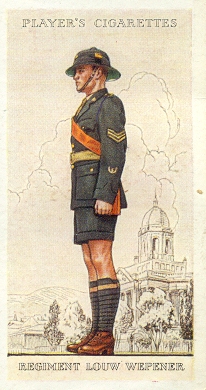

 The South African
The South African
Mr L J Head of Crystal Park contacted the South African National Museum of Military History recently to enquire about a unit represented on a cigarette card which he remembered from the war years, when he had been a schoolboy in England. This particular card, in a military series, illustrated a soldier in a green jacket, shorts and polo helmet. The caption on the card read ‘Regiment Louw Wepener’. Mr Head was interested to know, firstly, why he had not come across any reference to this particular unit during the Second World War and, secondly, what had since become of the unit.
The cigarette card in question was one in a series of a hundred, designed to be placed in a special ‘South African Defence’ album, and published by the United Tobacco Company during the Second World War. There is an example of this album in the Museum Archives.
Regiment Louw Wepener was one of six Afrikaans-speaking Active Citizen Force regiments established in 1934 as part of the expansion of the Union Defence Forces. Recruits were drawn from the Orange Free State and the unit’s headquarters were located in Ladybrand. The regiment was named after the Free State commandant, Louw Wepener, who was killed in 1865 during the 2nd Orange Free State—Basuto War at Thaba Bosiu, the former mountain stronghold of Moshoeshoe, founder of the Basuto nation.
An image of Thaba Bosiu forms the background of the regimental badge. A Vickers machine gun is superimposed on the mountain and the name ‘Thaba Bosigo’ appears below— this being the original Afrikaans spelling of the name of the mountain. Below the name is a shield with crossed spears above a scroll bearing the words ‘Reg Louw Wepener Reg’.
The uniform of the regiment, described in Mr Head’s letter, was worn by regiments of the UDF in the 1930s and early 1940s. It consisted of a grey-green field jacket, shorts, putties with yellow strings, brown boots, and polo helmet complete with unit flashes. Regimental badges were worn on the front of the polo helmet and on the jacket collars.
The reason for there having been no reference to the regiment during the Second World War was that both Regiment Louw Wepener and Regiment De Wet had been absorbed into Regiment President Steyn at the start of the war, all three regiments emanating from the Orange Free State. Regiment President Steyn served as a machine gun battalion with the 1st South African Division in North Africa in 1941—2. At one stage, Major J J W Swanepoel of Regiment Louw Wepener served as the unit’s second-in-command. In 1943, Lt Col Nel of Ladybrand took command of the further amalgamated Regiment Botha/ President Steyn.
In 1946, Regiment Louw Wepener was resuscitated as a citizen force unit. In 1960, it became Regiment Oos-Vrystaat (Regiment East Free State), but the original designation, Regiment Louw Wepener, was re-adopted in 1966. The regiment served under this name until well into the 1990s, when it was absorbed, together with Regiment Dan Pienaar, into Regiment Bloemspruit.
Sources
G Tylden, The Armed Forces of South Africa (Johannesburg, Frank Connock, 1954).
South African Defence, cigarette card album (United Tobacco Company).
South African Museum of Military History Library and Archives, File 355.31(68) Regt Louw Wepener.
Telephonic conversation by author with Regiment President Steyn, 24 October 2001.

For details and to contact him use:
http://www.chakoten.dk/cgi-bin/viewpic.cgi?gdir=plancher/wehrmacht36&galle
ry =be01&image=be00/004.jpg&pt=7&pn=4
Return to Journal Index OR Society's Home page
South African Military History Society / scribe@samilitaryhistory.org